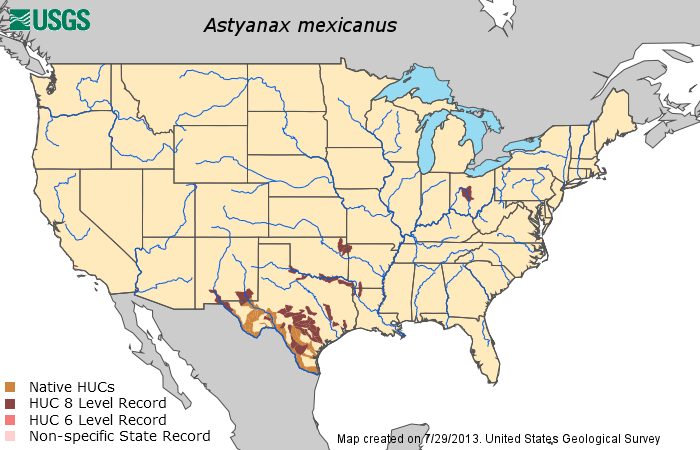
Habitat
The Astyanax mexicanus is a cavefish that is distributed in
Louisiana, Oklahoma, Arizona, New Mexico, Central Mexico, and
Texas. This species is native to the Rio Grande and possibly Nueces
River drainages (Texas Freshwater Fishes Texas State University
2013).

Caves are typically formed in karst, which is a landscape made from
limestone, dolomite, and gypsum rocks. Acidic water flows through
the Earth and creates a network of passages, creating an underground
plumbing system (National Geographic 2013). In caves they have
formations called speleothems, which hang from the ceiling of the
environment. This environment is draped in a shadow of darkness and
hides the uniqueness of the environment, but also allows for this
organism to thrive in (National Geographic 2013). For a similar
organism in this habitat click
here!
The Astyanax mexicanus originally camefrom a surface-dwelling species that once in a while invaded caves, but then reproduced multiple cave-adapted lineages. These surface dwelling populations of the Astyanax mexicanus prefer rocky and sandy-bottomed pools and creeks, streams and rivers (Arkive 2013). In the cave-adapted lineage, there are certain limitations due to the darkness of this specific habitat; such limitations include: food (because there is no primary productivity in caves) (Gallo and Jeffery 2012), reproduction, and spatial orientation. This habitat has also been a cause for the loss of coloration and loss of functioning eyes. However, the dark cave environment has allowed for the Astyanax mexicanus to evolve vibration attraction behaviors (click here for more information). The cavefish responds to low frequency water vibrations toward their source (Gallo and Jeffery 2012). Astyanax mexicanus can determine the size of its' environment and grow based on other sensory cues besides their sight.
Other organisms have been known with similar characteristics to the
Astyanax mexicanus, also live in the same environment. Many
troglolbites, or cave dwelling animals, assume similar life cycles
as this organism. They have evolved to live in this perpetual
darkness by having no skin pigmentations and may even be blind like
the Astyanax mexicanus (see
form and function). (Cave of the Winds 2013)